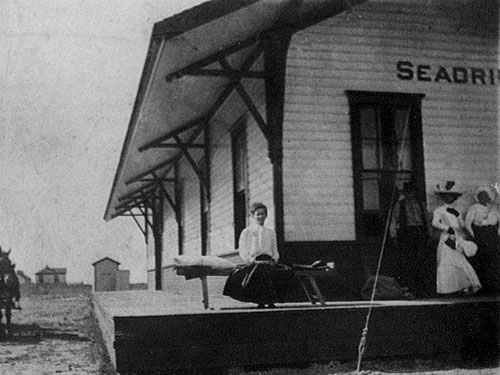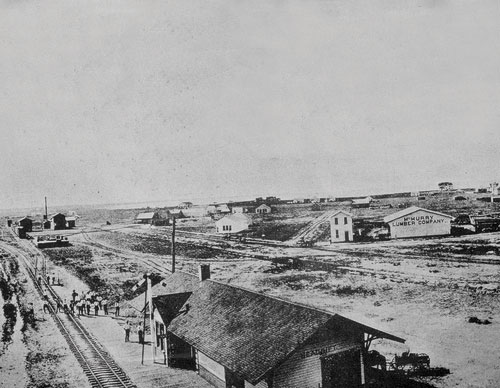As I settled down on the couch to enjoy the glow of the television, I heard a strong, loud whistle. In the town where I grew up, this sound was far more than familiar. I could almost set my watch to the daily bellow and its announcement of the train passing through. In Port Lavaca, however, I am no longer accustomed to hearing the sound; it is a rarity to hear the signaling device warning a train is approaching. Through out the journey of Discovering Seadrift, often I’ve wondered about the train depot which once was stationed in Seadrift. Many of the residents whom I’ve interviewed talk about the train and its conductor. As children, they all had a fascination with attracting the conductor’s attention. As I began my research to find out more about the locomotive, I didn’t realize the long journey I was about to encounter.
On June 6, 1903, the St. Louis, Brownsville and Mexico Railway (SLBM), also known as The Frisco; was chartered to run from Sinton to the Rio Grande at Brownsville with a branch extending westerly to the southeast corner of Starr County. The Port O’Connor (POC) Branch was one of the branches created which ran from Bloomington, Lela Pens and Seadrift to POC. March 1, 1910, the train depot was opened for business and used to freight large shipments of oysters and fish daily from Seadrift. By 1912, thousands of acres of cotton were grown and hauled to Seadrift to be ginned by the city’s new gin. The railway, over time merged with multiple lines and has numerous aliases, from the International – Great Northern Railroad (I&GN) to the SLBM to the Port O’Connor, Rio Grande and Northern Railway (PORG&N)—in the end it concluded as the Missouri Pacific Railroad (MoPac). The MoPac was one of the first railroads in the United States west of the Mississippi River which grew from a combination of a dozen mergers classifying it as a “Class I Railroad.” A Class I railroad is a large freight railroad company classified based on operating revenue. At the end of 1955, MoPac owned or leased 98 diesel units and 4,377 cars, with revenue of $461,554 and $15,759,273 of freight earnings.
The train depot remains standing in Seadrift, not in its exact location; however the building has survived to see 100 years old. If only those walls could talk, I’m sure we’d be in for some fascinating stories… Till next time!

Passengers wait to board the locomotive. -Photo courtesy of the Calhoun County Museum.
Railroad Timeline
December 1897 – Original embankment built in 1898 by Guadalupe Valley Railway was chartered and headed by Uriah Lott. This project fell through and no rails were laid, construction resumed under the aegis of the PORG&N.
June 1903 – The SLBM charter was amended on various dates after June 6th to provide an extension from Sinton to Houston and for the construction of branch lines to Collegeport, Victoria, Port O’Connor and Sam Fordyce to create a system known as the The Gulf Coast Lines. Benjamin Franklin Yoakum was president of the SLBM.
March 1, 1910 – The PORG&N Railway which was controlled by the SLBM, reached Seadrift in December 1909 and POC by February 1, 1910. The line between Bloomington, Seadrift and Port O’Connor measured a total of thirty-eight miles and was deemed the POC Branch which opened for business on March 1, 1910.
1910 – 1919 – The POC branch showed a daily round trip motor car between Victoria and POC including Sundays; the motor car laid overnight at POC. The only agency station between Bloomington and POC was Seadrift.
June 28, 1919 – Passenger train service to Seadrift ceased after the intense damage of the 1919 hurricane; population dwindled to 900.
January 1, 1925 – The SLBM became apart of the Missouri Pacific Lines. The line continued to operate as a separate company.
1933 – The line from Lela Pens to POC (16.70 miles) was abandoned.
March 1, 1956 – Missouri Pacific Lines was merged into the Missouri Pacific Railroad Company. All of the SLB&M lines were either abandoned or sold.
1969 – The line from Seadrift to Long Mott (8.60 miles) was abandoned.

The Seadrift Depot in 1910. -Photo courtesy of the Calhoun County Museum.
